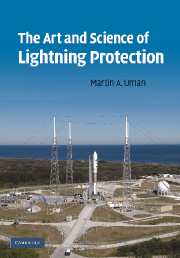Book contents
- Frontmatter
- Contents
- Preface
- 1 What is lightning?
- 2 Lightning damage
- 3 General methods for lightning protection: Faraday cages, topological shields; and more practical approaches: cone of protection and rolling sphere methods
- 4 Structure protection: air terminals and down conductors
- 5 Structure protection: grounding
- 6 Surge protection for electronics in low-voltage electrical systems
- 7 Humans and animals
- 8 Lightning warning
- 9 Airships, airplanes, and launch vehicles
- 10 Ships and boats
- 11 Trees
- 12 Overhead and underground power and communication lines
- 13 Lightning elimination
- 14 So, what do we know and what don't we know about lightning protection?
- Index
- References
10 - Ships and boats
Published online by Cambridge University Press: 17 November 2009
- Frontmatter
- Contents
- Preface
- 1 What is lightning?
- 2 Lightning damage
- 3 General methods for lightning protection: Faraday cages, topological shields; and more practical approaches: cone of protection and rolling sphere methods
- 4 Structure protection: air terminals and down conductors
- 5 Structure protection: grounding
- 6 Surge protection for electronics in low-voltage electrical systems
- 7 Humans and animals
- 8 Lightning warning
- 9 Airships, airplanes, and launch vehicles
- 10 Ships and boats
- 11 Trees
- 12 Overhead and underground power and communication lines
- 13 Lightning elimination
- 14 So, what do we know and what don't we know about lightning protection?
- Index
- References
Summary
History
Ships, the name given to large sea-worthy vessels, are generally made of electrically conducting metal, whereas boats, smaller vessels including speedboats, powerboats, motorboats, rowboats, and sailboats, are more often constructed of electrically insulating material such as fiberglass or wood. The metal shells of modern ships can be considered to be both an approximate Faraday cage and the outer surface of a topological shielded system (see Section 3.1), with the contact region between the electrically conducting hull and the ocean providing the grounding connection, and the ocean being the “ground.” Thus, modern ships do not suffer much lightning damage. What damage does occur is generally limited to exposed communication antennas, radars, and insulating covers for equipment. On the other hand, wood and fiberglass boats seldom encounter lightning without being damaged in some way. The US lightning protection standard NFPA 780:2004 devotes Chapter 8, Protection for Watercraft, to the methods of protection for powerboats and sailboats.
Ten years or so after Benjamin Franklin proposed a method for the lightning protection of both houses and ships (see Section 4.1), those principles were applied to the protection of wooden ships, wood being the only material from which ships were constructed at that time. The history of the lightning protection of the ships of the British Royal Navy is particularly interesting and has been reviewed by Bernstein and Reynolds (1978), from which some of the following discussion is taken.
- Type
- Chapter
- Information
- The Art and Science of Lightning Protection , pp. 175 - 185Publisher: Cambridge University PressPrint publication year: 2008



